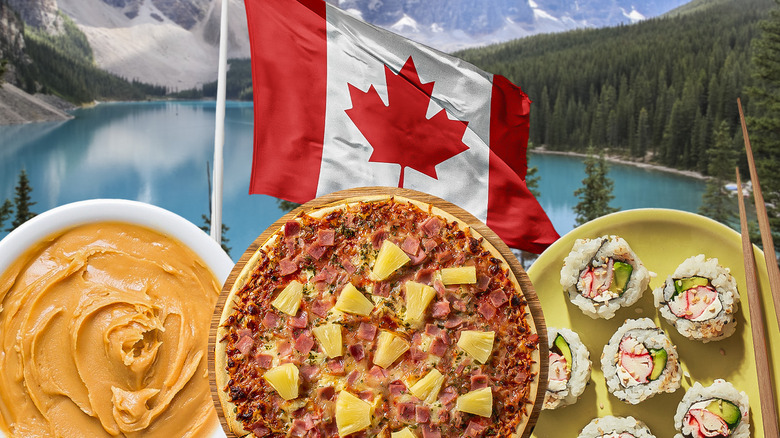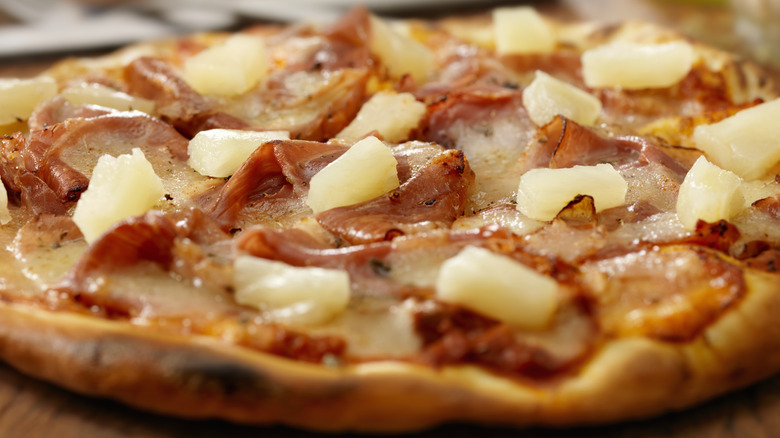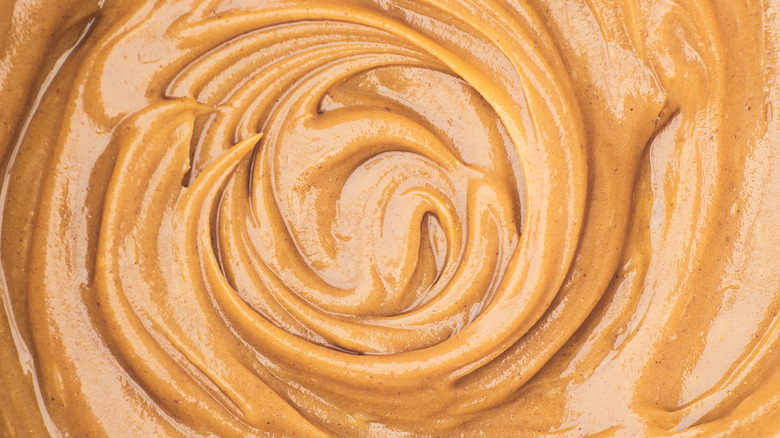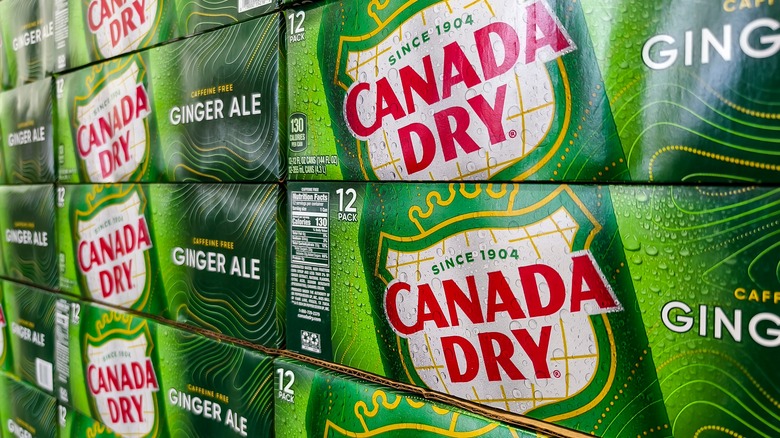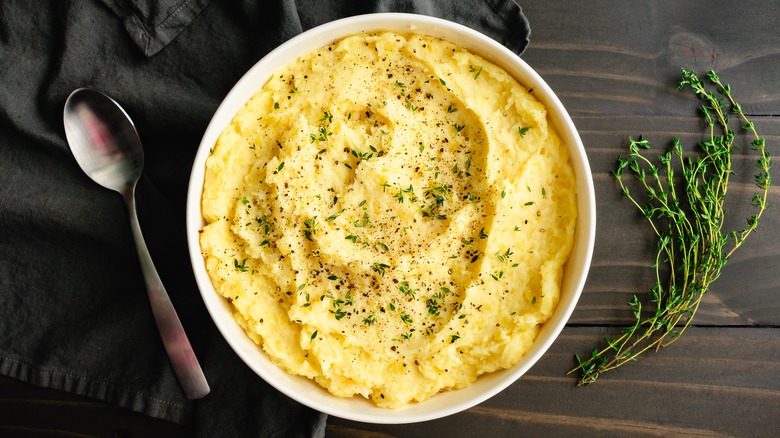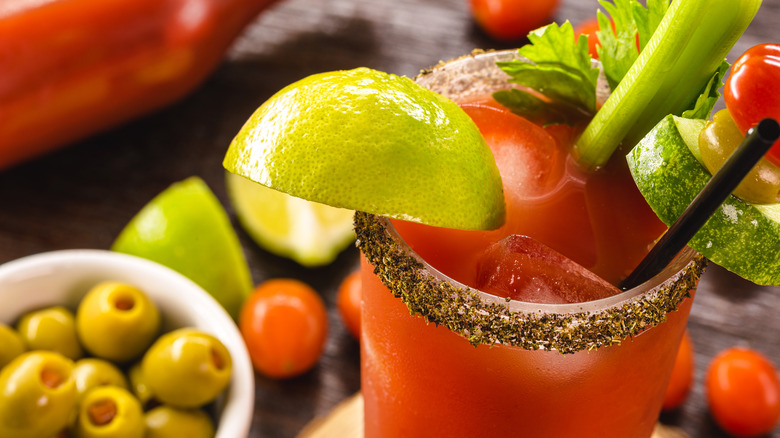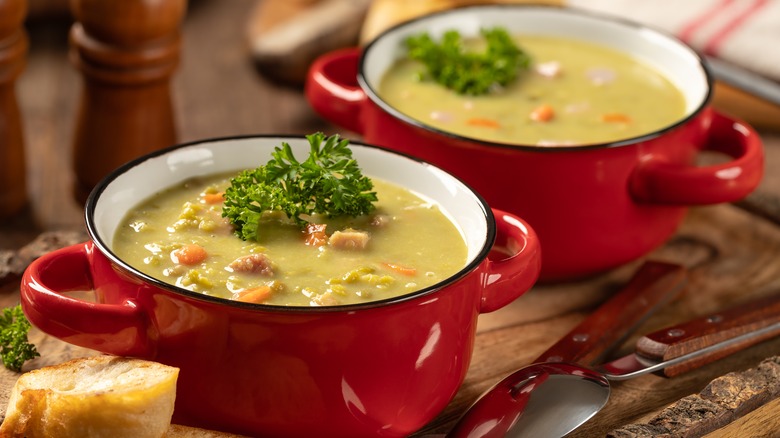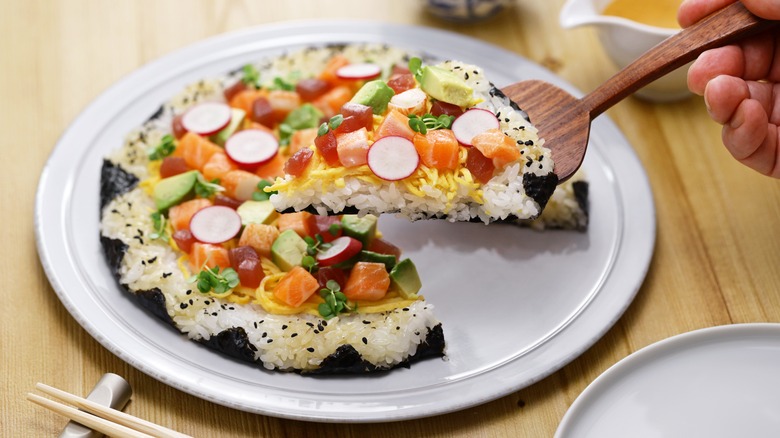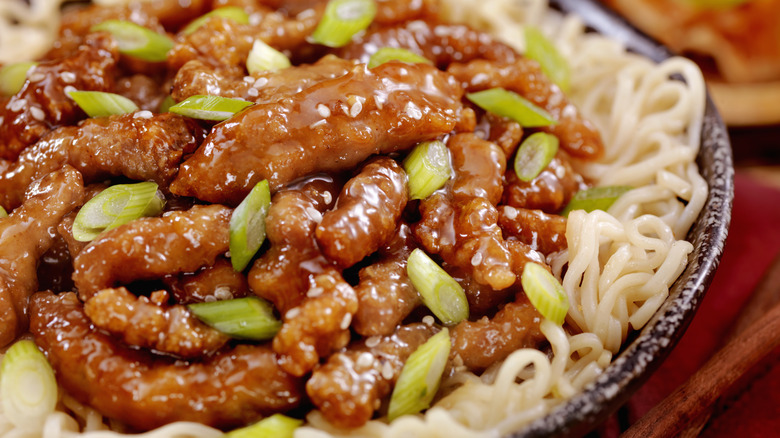9 Foods And Drinks You (Probably) Didn't Know Were Invented In Canada
We may receive a commission on purchases made from links.
"What is Canadian food?" Seems like a fairly easy question, but it has a not-so-simple answer, even for most Canadians. As a multicultural nation that's a part of the British Commonwealth, the country has struggled with to merge traditions and shape its own culinary identity in a similar way to how many parts of the U.S. have. That said, there are many foods that are known to be quintessentially Canadian, like poutine and Montreal smoked meats, and our northern neighbors have, over their history, also produced a number of dishes you might not realize originated in Canada.
Most people are familiar with Canadian delicacies like Canadian pea meal bacon or maple syrup. But, did you know that Hawaiian pizza, ginger ale, split pea soup, and, most shockingly, peanut butter, were all created north of the border? The details and origins of these dishes within the Great White North are as interesting as they are delicious.
Hawaiian pizza
Pineapple on pizza is a hotly debated topic. Some adore it, while others call it a "disgrace to humanity." Love it or hate it, this pizza concoction is purely Canadian. Hawaiian pizza was invented in 1962 by Greek-born diner owner Sam Panopoulos, in the town of Chatham, Ontario. Panopoulos was inspired by a stop over in Naples, Italy during his voyage to Canada, where he tried pizza for the first time. To add to the confusion, Hawaiian pizza gets its name from the brand of canned pineapples Panopoulos used.
Canned pineapple had become ubiquitous in most households and restaurants by the early 1960s. Along the same time, the sweet and salty flavors of Westernized Chinese cuisine was becoming popular across the continent, including at Panopoulos' restaurant, Satellite. So, he thought nothing of adding pineapple atop a pizza dotted with ham. As he predicted, it was a hit with customers. Panopoulos sadly passed away in 2017, so you won't be able to taste his original recipe, but variations of this dish exist all across Canada and the U.S. (even making its way to Pizza Hut's menu).
Peanut butter
Growing up in the U.S., many of us were taught that George Washington Carver invented peanut butter. While Dr. Carver was an extremely prolific inventor and an incredible visionary and ambassador for the peanut industry, he did not invent peanut butter. Peanut butter can be traced all the way back to Ancient Incas and the Aztecs, but in more modern times, it was a Canadian chemist and pharmacist who first ground peanuts into an edible paste.
For a food so steeped in American culture, it's quite the upset that it originated in Canada. In 1884, a druggist named Marcellus Gilmore Edson, a Montreal resident, patented a recipe for peanut paste. It was a first, although it wasn't the last; other inventors and scientists, including the inventor of Kellogg's cereal, Dr. John Harvey Kellogg, would go on to perfect the paste into the creamy, heavenly butter we all enjoy today.
Today, the most popular brand of peanut butter in Canada is Kraft. Fortunately, you won't have to travel abroad to try this treat, as it is available on Amazon, including the all-natural variety.
Canada Dry ginger ale
It may not be surprising as it's in the name, but Canada Dry ginger ale is a true Canadian. It sits politely in the soft drink aisle with its name and logo clearly displayed, yet many people are unaware that it was actually conceived in Canada. Invented in 1904 by Toronto-based pharmacist and sparkling water plant owner John McLaughlin, Canada Dry's unique ginger ale was originally called pale ginger ale. The dry moniker came a bit later as McLaughlin's product was noticeably less sweet than his competitor's; an original recipe for ginger ale hails from Ireland, where it was darker, sweeter, and packed a fermented punch of spice.
Known as the "champagne of soda", Canada Dry served the very noble purpose of masking the harsh taste of illegally manufactured liquor during Prohibition. Thus, it became popular all across North America (and now the world).
The brand has deviated from its original dry routes, favoring an overly sweet taste like its competitors, and has been in hot water for false ingredient and health benefit claims. It's also no longer produced in or owned by Canadians (even its logo which had a map of Canada was changed in 2000). However, it's still one of the top soda brands globally and can be purchased almost anywhere.
Beavertails
Not to be confused with the strange appeal of tiger tail ice cream, Beavertails were invented in Canada's capital city, but that's not where its political connections end. In 2009, President Obama visited the original Beavertail kiosk in the historic Byward Market culinary district in Ottawa, Ontario. The stand opened in 1980 when founders Grant and Pam Hooker turned their beloved family recipe into a business.
Beavertails are so named for their flat, tail-like shape. They are deep fried dough that is topped with cinnamon and sugar, as well as the tantalizing addition of fresh lemon juice squeezed on top right before eating. A beaver's tail might also include Nutella, marshmallows, chocolate chunks, or other personalized toppings.
Beavertails aren't the only sweet-tooth satisfying treat to come out of Canada; many are familiar with the Naniamo bar, a stacked treat of yellow custard center layered between coconut and graham cracker base and a chocolate top. Though these also come from the eastern seaboard (the province of British Columbia), the beavertail specialty is all Ontario.
While you may be tempted to visit Ottawa in the warmer months, Stefanie Siska of C'est Bon Food Tours Ottawa recommends having a Beavertail while skating on the Rideau Canal. "Beavertails are best enjoyed in wintertime," she says "when the lemon and sugar crystalizes by your last bite."
Instant mashed potatoes
Speaking of comfort food, few things satisfy the immediate need for safety quite like mashed potatoes and gravy. However, sometimes when we're seeking that comfort the thought of cleaning, peeling, boiling, and mashing potatoes seems like a monumental task. In those times, were are willing to sacrifice a bit of the flavor and texture for immediacy. Enter: instant mashed potatoes.
Although various forms of dehydrated potatoes existed prior to World War I, instant mashed potatoes were invented by Canadian Department of Agriculture in Ottawa employee and food chemist Edward Anton Maria Asselbergs. Earlier forms of ready-made mashed potatoes often resulted in unappealing textures and tastes when reconstituted. Instead of the flakes and granules of older versions, Asselbergs' patent was for potatoes that were prepared into "crystal-like particles" that broke down to a smoother finish in hot water (or milk). They quickly became a fast convenience food for homemakers of the post-war generation, as well as those purchasing foods with longer shelf lives.
These crystalized potato particles hit shelves in Ottawa in the late 1950s. The dehydrated spuds probably aren't your first choice when you're craving mashed potatoes, but they're as close as you'll get without having to do all the work on your own.
Bloody Caesar
Mention the words "bloody mary" and you've immediately triggered associations with brunch (and also, maybe, airplanes). So, you may be surprised to know that the mary's clammy cousin, the Bloody Caesar, was invented by Walter Chell in Calgary in 1969. In the event you're unfamiliar, a Bloody Caesar consists of the typical bloody Mary fixings, with the addition of clam juice. A combination product of tomato and clam juice is now sold bottled as Clamato, which may be one of the strangest food inventions, but that doesn't mean strange can't be tasty.
The Bloody Caesar is Canada's national cocktail, and it's bloody good. The clam/tomato juice combination is more subtle than you might think and the addition of olives, celery, pickled green beans made it feel more like a snack than just a standard cocktail. Canadians drink more than 400 million Caesars annually, but many people outside of Canada have never even heard of this drink. You can still sample this savory cocktail at the Westin in Calgary (formerly the Calgary Inn), but many bars around the country have personalized versions of this cocktail, too.
Split pea soup
This hearty, warming dish perfect for chilly nights comes from the providence of Québec. Known by Québecois locals as habitant soup or soupe aux pois cassés so named for Canada's first settlers, the habitants who arrived from France in the early 1600s.
The basis of the dish is yellow split peas, a ham hock, and whatever vegetables you have on hand. Traditionally, a ham hock is used, many saying it must be used, but more modern additions of salted pork and roasted ham are used by many now-a-days. This soup was a largely unknown outside of Québec for almost 300 years, after which it was rumored to have been brought to New England by French Canadian mill workers. Whether you use a ham hock or an untraditional choice (make it a vegan recipe!) this dish is best enjoyed at home, whether cooked by you or a loved one. Ultimately, the best comfort food is care.
Sushi pizza
While the origins of the California roll are suspected to be Canadian but remain unknown, another raw fish dish was first served in Toronto. It was crafted by the Kobe born French (not sushi) chef Kaoru Ohsada while working at Nami Restaurant. Inspired by a California roll he sampled, Chef Ohsada was inspired to create something completely different than anything served on the Nami menu. Perhaps even more polarizing than a Hawaiian pie, this "pizza" contains no cheese, sauce, or even crust.
Chef Ohsada took leftover sushi rice, fried it, and topped it with raw salmon, chopped onions and tobiko (fish eggs) and dubbed it sushi pizza. He later added spicy mayo and a soy-wasabi combination sauce to this dish, and you can still enjoy this culinary curiosity at the original Nami location in Toronto. Regardless of your taste preferences, it can't be denied that Canadians really know how to create polarizing pizza recipes.
Ginger beef
Ginger beef is one of the most popular Canadian-Chinese dishes in Canada, and for good reason. It was created in Calgary in the 1970s at the Silver Inn Restaurant by chef George Wong. Chef Wong anticipated that his dish would very appealing to the growing amount of local cravings for dishes both sweet and savory. The dish is made up of fried beef strips, cut into strips to replicate French fries to encourage western palates to give other kinds of foods a chance. It also has ginger, of course, a melange of veggies such as carrots, ginger, sesame oil, and spices. The satisfying, signature crunchiness of the beef was due to it being battered, then fried.
The Silver Inn Restaurant closed permanently in 2022, so you won't have a chance to try the original in person. You can try to attempt the recipe at home (or something similar), or simply order takeout.
